The Course of the Corset. Part 1: Ancient of Days
The Origins of the the Over The Shoulder, Boulder Holder.
Shh, today we're talking about something very secret to a woman. Something that she privately holds close to her chest. I see those eyes widening with every word on this page. Wait! Allison is talking about what?
The corset, silly! What else did you think I was talking about?
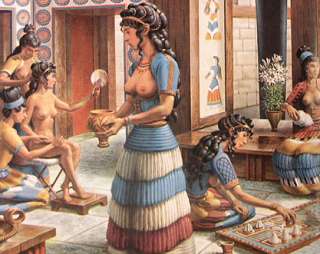 Corsets have been around for over 2,000 years. The first known culture to have worn the corset were the Minoans. The Minoans inhabited the island of Crete between 3000 and 1600 B.C. A complex society, their culture wasn't known to have existed until the discovery of one of their cities in the 1800's. Much of what we know about them come from the artwork they had left behind and other forms of archaeological evidence. Minoan society was not a male dominated culture but matrilineal, meaning heritage and identity was passed from mother to daughter. Women held important roles in their society as priestess, administrators, and often played sports such as bull fighting. The Minoan garments consisted of different complex pieces that were sewn much in the same way as modern clothing. A Minoan woman's attire predated the Victorian fashions but were unmistakably similar, with the exception of the how she wore her corset. Her corset was worn on the outside of her body and pushed up to heighten her exposed breasts. Sometimes she would wear a blouse over the corset but her breasts always remained exposed. A woman's skirt was bell shaped and tight fitting. The bell shape was achieved by wearing hoops underneath the skirt. The desired shape for women were large breasts and a tiny waist, the same fashionable shape the Victorians had desired. Both Minoan men and women wanted a small waist. As children, both genders wore a girdle around their waists that was tightened as they grew in order to stop growth in the waist area.
Corsets have been around for over 2,000 years. The first known culture to have worn the corset were the Minoans. The Minoans inhabited the island of Crete between 3000 and 1600 B.C. A complex society, their culture wasn't known to have existed until the discovery of one of their cities in the 1800's. Much of what we know about them come from the artwork they had left behind and other forms of archaeological evidence. Minoan society was not a male dominated culture but matrilineal, meaning heritage and identity was passed from mother to daughter. Women held important roles in their society as priestess, administrators, and often played sports such as bull fighting. The Minoan garments consisted of different complex pieces that were sewn much in the same way as modern clothing. A Minoan woman's attire predated the Victorian fashions but were unmistakably similar, with the exception of the how she wore her corset. Her corset was worn on the outside of her body and pushed up to heighten her exposed breasts. Sometimes she would wear a blouse over the corset but her breasts always remained exposed. A woman's skirt was bell shaped and tight fitting. The bell shape was achieved by wearing hoops underneath the skirt. The desired shape for women were large breasts and a tiny waist, the same fashionable shape the Victorians had desired. Both Minoan men and women wanted a small waist. As children, both genders wore a girdle around their waists that was tightened as they grew in order to stop growth in the waist area.
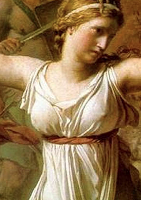 Not all women of ancient civilization wore a corset but they did have ways to support their breasts. In ancient Greece, females were prohibited from wearing a corset. Grecian women wore nothing underneath their robes. Men and women both wore a belt around their waist called a zona. Sex in their culture was considered only for procreating. Men viewed women as a necessary evil in order to bear their children. Whereas they only tolerated sex with women, men were more willing to have relations with boys. Grecian society valued the perfection of the human body above all else, especially in males. A woman held no property rights, could not read or write, participate in outside activities and had no say in whom she would marry. It was her obligation to give her husband a son. If she did not she was considered a disgrace. Women who bore daughters would be shamed. Fathers did not claim their own daughters. Women were expected to conceal and minimize their breasts as much as possible with the use of the strophion and the apodesmos. Underneath her tunic, she wore narrow bands of cloth on top of her breasts known as apodesmos. These were made of wool or leather and were pinned along her back. After placing her tunic on, the Grecian woman would twist a narrow band of cloth (strophion) then wrap it around and underneath her breasts. The intention not only minimize her breasts but was also meant to bind her breasts so they would not move.
Not all women of ancient civilization wore a corset but they did have ways to support their breasts. In ancient Greece, females were prohibited from wearing a corset. Grecian women wore nothing underneath their robes. Men and women both wore a belt around their waist called a zona. Sex in their culture was considered only for procreating. Men viewed women as a necessary evil in order to bear their children. Whereas they only tolerated sex with women, men were more willing to have relations with boys. Grecian society valued the perfection of the human body above all else, especially in males. A woman held no property rights, could not read or write, participate in outside activities and had no say in whom she would marry. It was her obligation to give her husband a son. If she did not she was considered a disgrace. Women who bore daughters would be shamed. Fathers did not claim their own daughters. Women were expected to conceal and minimize their breasts as much as possible with the use of the strophion and the apodesmos. Underneath her tunic, she wore narrow bands of cloth on top of her breasts known as apodesmos. These were made of wool or leather and were pinned along her back. After placing her tunic on, the Grecian woman would twist a narrow band of cloth (strophion) then wrap it around and underneath her breasts. The intention not only minimize her breasts but was also meant to bind her breasts so they would not move.
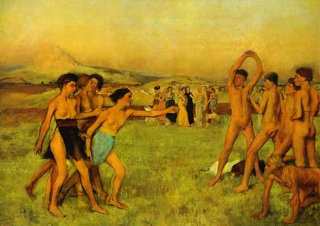 While the classical Grecian woman strove to conceal her femininity, her Spartan counterparts were different. Spartan girls and boys were trained in the nude for battle. A Spartan woman had more rights than the classical Grecian female. She was educated to read and write, trained in athletics and was able to hold property rights. Although trained in the nude, the Spartan women did wear support when they were in battle.
While the classical Grecian woman strove to conceal her femininity, her Spartan counterparts were different. Spartan girls and boys were trained in the nude for battle. A Spartan woman had more rights than the classical Grecian female. She was educated to read and write, trained in athletics and was able to hold property rights. Although trained in the nude, the Spartan women did wear support when they were in battle.
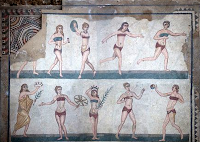
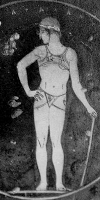 Atalanta by EualonThe most famous Spartan female warrior, Atalanta, was painted by Eualon around 450BC wearing undergarments that were commonly used by Spartan women in battle. The stethodesmos and diazoma were similar to what the classical Grecian women wore for support with one exception, they were worn in the nude. The stethodesmos, a more elaborate form of the apodesmos, consisted of straps that held the cloth instead of tying or pinning together along the woman's back. The piece of clothing more closely resembled a modern day exercise bra. Instead of wearing a tunic, a Spartan woman wore the diazoma. A diazoma was basically a loin cloth. The purpose of both garments were to allow the female warrior more freedom to move in battle. By binding her breasts she had a greater range of motion.
Atalanta by EualonThe most famous Spartan female warrior, Atalanta, was painted by Eualon around 450BC wearing undergarments that were commonly used by Spartan women in battle. The stethodesmos and diazoma were similar to what the classical Grecian women wore for support with one exception, they were worn in the nude. The stethodesmos, a more elaborate form of the apodesmos, consisted of straps that held the cloth instead of tying or pinning together along the woman's back. The piece of clothing more closely resembled a modern day exercise bra. Instead of wearing a tunic, a Spartan woman wore the diazoma. A diazoma was basically a loin cloth. The purpose of both garments were to allow the female warrior more freedom to move in battle. By binding her breasts she had a greater range of motion.
Next Tuesday we will explore how two women changed the form of the corset and a woman's body during the Renaissance.

Shh, today we're talking about something very secret to a woman. Something that she privately holds close to her chest. I see those eyes widening with every word on this page. Wait! Allison is talking about what?
The corset, silly! What else did you think I was talking about?
 Corsets have been around for over 2,000 years. The first known culture to have worn the corset were the Minoans. The Minoans inhabited the island of Crete between 3000 and 1600 B.C. A complex society, their culture wasn't known to have existed until the discovery of one of their cities in the 1800's. Much of what we know about them come from the artwork they had left behind and other forms of archaeological evidence. Minoan society was not a male dominated culture but matrilineal, meaning heritage and identity was passed from mother to daughter. Women held important roles in their society as priestess, administrators, and often played sports such as bull fighting. The Minoan garments consisted of different complex pieces that were sewn much in the same way as modern clothing. A Minoan woman's attire predated the Victorian fashions but were unmistakably similar, with the exception of the how she wore her corset. Her corset was worn on the outside of her body and pushed up to heighten her exposed breasts. Sometimes she would wear a blouse over the corset but her breasts always remained exposed. A woman's skirt was bell shaped and tight fitting. The bell shape was achieved by wearing hoops underneath the skirt. The desired shape for women were large breasts and a tiny waist, the same fashionable shape the Victorians had desired. Both Minoan men and women wanted a small waist. As children, both genders wore a girdle around their waists that was tightened as they grew in order to stop growth in the waist area.
Corsets have been around for over 2,000 years. The first known culture to have worn the corset were the Minoans. The Minoans inhabited the island of Crete between 3000 and 1600 B.C. A complex society, their culture wasn't known to have existed until the discovery of one of their cities in the 1800's. Much of what we know about them come from the artwork they had left behind and other forms of archaeological evidence. Minoan society was not a male dominated culture but matrilineal, meaning heritage and identity was passed from mother to daughter. Women held important roles in their society as priestess, administrators, and often played sports such as bull fighting. The Minoan garments consisted of different complex pieces that were sewn much in the same way as modern clothing. A Minoan woman's attire predated the Victorian fashions but were unmistakably similar, with the exception of the how she wore her corset. Her corset was worn on the outside of her body and pushed up to heighten her exposed breasts. Sometimes she would wear a blouse over the corset but her breasts always remained exposed. A woman's skirt was bell shaped and tight fitting. The bell shape was achieved by wearing hoops underneath the skirt. The desired shape for women were large breasts and a tiny waist, the same fashionable shape the Victorians had desired. Both Minoan men and women wanted a small waist. As children, both genders wore a girdle around their waists that was tightened as they grew in order to stop growth in the waist area. Not all women of ancient civilization wore a corset but they did have ways to support their breasts. In ancient Greece, females were prohibited from wearing a corset. Grecian women wore nothing underneath their robes. Men and women both wore a belt around their waist called a zona. Sex in their culture was considered only for procreating. Men viewed women as a necessary evil in order to bear their children. Whereas they only tolerated sex with women, men were more willing to have relations with boys. Grecian society valued the perfection of the human body above all else, especially in males. A woman held no property rights, could not read or write, participate in outside activities and had no say in whom she would marry. It was her obligation to give her husband a son. If she did not she was considered a disgrace. Women who bore daughters would be shamed. Fathers did not claim their own daughters. Women were expected to conceal and minimize their breasts as much as possible with the use of the strophion and the apodesmos. Underneath her tunic, she wore narrow bands of cloth on top of her breasts known as apodesmos. These were made of wool or leather and were pinned along her back. After placing her tunic on, the Grecian woman would twist a narrow band of cloth (strophion) then wrap it around and underneath her breasts. The intention not only minimize her breasts but was also meant to bind her breasts so they would not move.
Not all women of ancient civilization wore a corset but they did have ways to support their breasts. In ancient Greece, females were prohibited from wearing a corset. Grecian women wore nothing underneath their robes. Men and women both wore a belt around their waist called a zona. Sex in their culture was considered only for procreating. Men viewed women as a necessary evil in order to bear their children. Whereas they only tolerated sex with women, men were more willing to have relations with boys. Grecian society valued the perfection of the human body above all else, especially in males. A woman held no property rights, could not read or write, participate in outside activities and had no say in whom she would marry. It was her obligation to give her husband a son. If she did not she was considered a disgrace. Women who bore daughters would be shamed. Fathers did not claim their own daughters. Women were expected to conceal and minimize their breasts as much as possible with the use of the strophion and the apodesmos. Underneath her tunic, she wore narrow bands of cloth on top of her breasts known as apodesmos. These were made of wool or leather and were pinned along her back. After placing her tunic on, the Grecian woman would twist a narrow band of cloth (strophion) then wrap it around and underneath her breasts. The intention not only minimize her breasts but was also meant to bind her breasts so they would not move. While the classical Grecian woman strove to conceal her femininity, her Spartan counterparts were different. Spartan girls and boys were trained in the nude for battle. A Spartan woman had more rights than the classical Grecian female. She was educated to read and write, trained in athletics and was able to hold property rights. Although trained in the nude, the Spartan women did wear support when they were in battle.
While the classical Grecian woman strove to conceal her femininity, her Spartan counterparts were different. Spartan girls and boys were trained in the nude for battle. A Spartan woman had more rights than the classical Grecian female. She was educated to read and write, trained in athletics and was able to hold property rights. Although trained in the nude, the Spartan women did wear support when they were in battle. 
 Atalanta by EualonThe most famous Spartan female warrior, Atalanta, was painted by Eualon around 450BC wearing undergarments that were commonly used by Spartan women in battle. The stethodesmos and diazoma were similar to what the classical Grecian women wore for support with one exception, they were worn in the nude. The stethodesmos, a more elaborate form of the apodesmos, consisted of straps that held the cloth instead of tying or pinning together along the woman's back. The piece of clothing more closely resembled a modern day exercise bra. Instead of wearing a tunic, a Spartan woman wore the diazoma. A diazoma was basically a loin cloth. The purpose of both garments were to allow the female warrior more freedom to move in battle. By binding her breasts she had a greater range of motion.
Atalanta by EualonThe most famous Spartan female warrior, Atalanta, was painted by Eualon around 450BC wearing undergarments that were commonly used by Spartan women in battle. The stethodesmos and diazoma were similar to what the classical Grecian women wore for support with one exception, they were worn in the nude. The stethodesmos, a more elaborate form of the apodesmos, consisted of straps that held the cloth instead of tying or pinning together along the woman's back. The piece of clothing more closely resembled a modern day exercise bra. Instead of wearing a tunic, a Spartan woman wore the diazoma. A diazoma was basically a loin cloth. The purpose of both garments were to allow the female warrior more freedom to move in battle. By binding her breasts she had a greater range of motion.Next Tuesday we will explore how two women changed the form of the corset and a woman's body during the Renaissance.
Published on June 26, 2012 12:17
No comments have been added yet.



